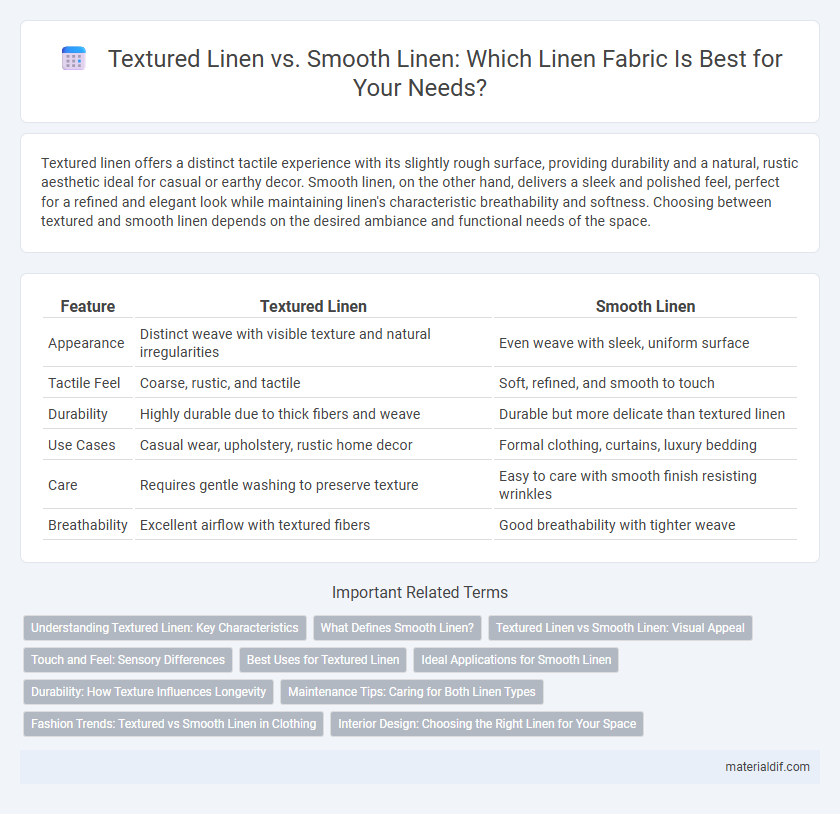Textured linen offers a distinct tactile experience with its slightly rough surface, providing durability and a natural, rustic aesthetic ideal for casual or earthy decor. Smooth linen, on the other hand, delivers a sleek and polished feel, perfect for a refined and elegant look while maintaining linen's characteristic breathability and softness. Choosing between textured and smooth linen depends on the desired ambiance and functional needs of the space.
Table of Comparison
| Feature | Textured Linen | Smooth Linen |
|---|---|---|
| Appearance | Distinct weave with visible texture and natural irregularities | Even weave with sleek, uniform surface |
| Tactile Feel | Coarse, rustic, and tactile | Soft, refined, and smooth to touch |
| Durability | Highly durable due to thick fibers and weave | Durable but more delicate than textured linen |
| Use Cases | Casual wear, upholstery, rustic home decor | Formal clothing, curtains, luxury bedding |
| Care | Requires gentle washing to preserve texture | Easy to care with smooth finish resisting wrinkles |
| Breathability | Excellent airflow with textured fibers | Good breathability with tighter weave |
Understanding Textured Linen: Key Characteristics
Textured linen features irregular slubs and visible fibers that create a tactile, organic feel, distinguishing it from smooth linen's sleek surface. This fabric's natural variations enhance breathability and durability, making it ideal for home decor and casual apparel. Understanding textured linen's unique weave and fiber structure is essential for selecting the right linen based on comfort and aesthetic preferences.
What Defines Smooth Linen?
Smooth linen is defined by its finely woven fibers that create a sleek, even surface with minimal texture. This type of linen typically undergoes additional processing, such as bleaching and calendaring, to achieve a soft, polished feel. Smooth linen is prized for its lightweight breathability and refined appearance, making it ideal for garments and home textiles that prioritize comfort and elegance.
Textured Linen vs Smooth Linen: Visual Appeal
Textured linen features a pronounced weave and tactile surface that adds depth and character, enhancing its visual appeal in rustic and natural-themed interiors. Smooth linen offers a sleek, refined look with a subtle shimmer, making it ideal for contemporary and minimalist designs. Choosing between textured and smooth linen depends on the desired aesthetic impact, as textured linen emphasizes organic warmth while smooth linen highlights elegance and simplicity.
Touch and Feel: Sensory Differences
Textured linen features a tactile surface with noticeable irregularities that provide a rustic, natural feel, ideal for adding depth and character to fabrics. Smooth linen offers a sleek, soft touch that enhances comfort and creates a refined, elegant appearance suitable for formal wear and bedding. The sensory difference lies in textured linen's rougher, more organic sensation versus smooth linen's cool, crisp, and gentle hand feel.
Best Uses for Textured Linen
Textured linen offers enhanced durability and a visually rich surface, making it ideal for upholstery, drapery, and throw pillows where tactile appeal and resilience are essential. Its natural slubs and irregularities add character that complements rustic, bohemian, and farmhouse decor styles. Textured linen also performs well in high-traffic areas due to its thicker weave and ability to hide wear and stains better than smooth linen.
Ideal Applications for Smooth Linen
Smooth linen, known for its refined and sleek surface, is ideal for applications requiring a polished and elegant appearance such as formal clothing, luxury bed linens, and drapery. Its soft texture enhances comfort and drape, making it perfect for tailored garments and high-end home textiles. Smooth linen's durability combined with its smooth finish ensures long-lasting use in premium fashion and sophisticated interior design.
Durability: How Texture Influences Longevity
Textured linen exhibits enhanced durability due to its thicker weave and raised fiber patterns, which provide greater resistance to wear and tear over time compared to smooth linen. The uneven surface structure of textured linen helps disperse stress more effectively, reducing the likelihood of fabric weakening or pilling. Smooth linen, while offering a sleek appearance, tends to show signs of wear more quickly as its finer weave is more susceptible to abrasion and damage from frequent use.
Maintenance Tips: Caring for Both Linen Types
Textured linen requires gentle washing in cold water with mild detergent to preserve its unique weave and prevent fraying, while smooth linen benefits from ironing at medium heat to maintain its sleek appearance and reduce wrinkles. Both linen types should be air-dried flat or hung to avoid shrinkage and distortion, and storing them in breathable fabric bags helps prevent moisture buildup and mildew. Avoid bleach and harsh chemicals on both textured and smooth linen to extend fiber longevity and maintain fabric integrity.
Fashion Trends: Textured vs Smooth Linen in Clothing
Textured linen, characterized by its slubbed, uneven surface, adds depth and visual interest to contemporary fashion, making it a popular choice for casual, breathable summer wear with a relaxed, artisanal vibe. Smooth linen, prized for its sleek finish and crisp appearance, dominates formal and tailored designs, offering a polished, sophisticated aesthetic favored in high-end fashion collections and business attire. Current fashion trends highlight a blend of both linen types, with textured linen gaining momentum for its organic appeal, while smooth linen remains essential for structured, elegant looks.
Interior Design: Choosing the Right Linen for Your Space
Textured linen adds depth and visual interest to interior spaces, creating a cozy and inviting atmosphere ideal for rustic or bohemian styles. Smooth linen offers a sleek, refined look perfect for modern, minimalist designs, enhancing light reflection and a sense of spaciousness. Selecting the right linen depends on the desired ambiance and complementing existing textures within the room's decor.
Textured Linen vs Smooth Linen Infographic

 materialdif.com
materialdif.com